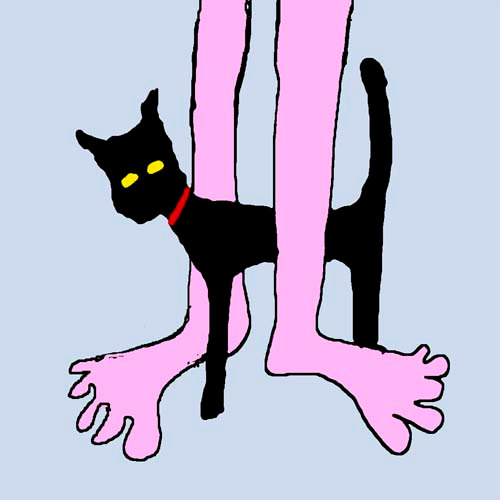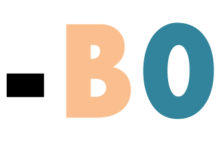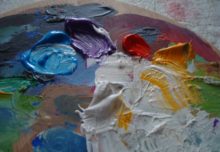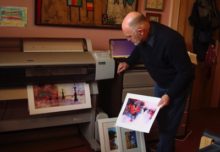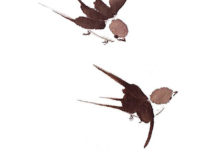ANIMALS AS AN ART SUBJECT.
Many artists have depicted animals in their art. Myself included.
In my case I have painted our black cat many, many, times. But I have never been tempted to have a go at other species of animal, dogs, lions, or horses for instance.
One of the most famous British horse painters was George Stubbs. Alfred Munnings is another. Maybe the horse in Picasso’s Guernica is better known worldwide.
However the horse has a much longer art history than these artists. The Uffington White Horse cut into the chalky hillside in the Berkshire Downs is 3000 years old.

The Uffington White Horse
And most of the earliest artworks known to us are paintings of animals.
I am thinking about cave paintings of course.
These are actually ‘pictographs’.
From Wikipedia: Pictographs are paintings or drawings that have been placed onto the rock face. Such artworks have typically been made with mineral earths and other natural compounds found across much of the world. The predominantly used colours are red, black and white. Red paint is usually attained through the use of ground ochre, while black paint is typically composed of charcoal, or sometimes from minerals such as manganese. White paint is usually created from natural chalk, kaolinite clay or diatomaceous earth.[19] Once the pigments had been obtained, they would be ground and mixed with a liquid, such as water, blood, urine, or egg yolk, and then applied to the stone as paint using a brush, fingers, or a stamp. Alternately, the pigment could have been applied on dry, such as with a stick of charcoal.[20] In some societies, the paint itself has symbolic and religious meaning; for instance, among hunter-gatherer groups in California, paint was only allowed to be traded by the group shamans, while in other parts of North America, the word for “paint” was the same as the word for “supernatural spirit”.
So, is this blog is about the earliest art subject in the history of art? Not quite!
The oldest cave-art is over 40,000 years old showing human hand stencils made by blowing pigment at a hand held on the cave wall. Examples have been found in Europe, Australia, Asia and Africa. In South Africa hatched patterns on pieces of ochre date much earlier still. Maybe even 70,000 years ago. So animals became art following abstract pattern and human hands.
However the oldest animal pictures are still very old. In France cave paintings date from over 30,000 years ago. They show predatory animals such as cave lions, panthers, and hyenas.
This was in the Upper Paleolithic era, which ended 10,000 years ago. At that time Homo Sapiens were hunter gatherers. This was in the pre-agriculture period. People were thin on the ground, with little competition for the berries and plants that formed most of their food, meaning that humans had more time for leisure. They had time to create tools, weapons, music, agriculture, and indulge in a bit of art.
People did eat meat as well. Some of which they hunted and killed. But possibly most meat came from scavenged animal corpses and prey that was driven off cliffs etc.. No doubt animals were prized as food. But at the same time animals competed with us for the easy pickings. Birds ate the berries, herbivores ate the best plants, and quicker and specialised animals ate other weak, young, or old animals, who were our ideal prey species. The most ferocious animals also threatened human society. Animals wanted to eat us. We learned to share our time on Earth with animals in a respectful co-existence sort of way.
But we knew that we were a bit cleverer than them.
So humans went deep into the darkest caves and painted animals on the walls. Maybe that helped.
Then about 10,000 years ago there was an end to the last ice age and the world climate became benign. We learned how to grow food, which meant that we worked much harder and longer. But we had to say put to benefit from all the hard work. We tamed and herded animals. We wiped out some species and helped other varieties to thrive under our control. Animals became our regular food, and supplied milk and leather and even transport, and before the steam engine they became our major labour source.
We still drew and painted animals. We ‘discovered’ anthropomorphic qualities in animals. We even included animals into religious activity. In fact at that time some animals were seen as godlike. The cow is seen as a symbol of life and is treated with great respect by Hindus. The Lamb of God is another example.
Artists lived and coexisted respectively with animals, and have continued to depict animals ever since.
Some artists have specialised in animal paintings. Afore-mentioned Stubbs and Munnings are examples. Other artists, like Henri Rousseau [tigers] and Pablo Picasso [bulls], have included animals as dynamic central subjects.
While others, like me, have just painted black cats.
Click here to see my Black Cat signed cards, available on Etsy.com

